What Does Scanning And Repairing Drive D Mean
CHKDSK has been effectually since earlier the days of Windows. This utility has in some ways changed dramatically for new environments and new disk formats. Yet in other means, it's pretty much the same erstwhile disk checking utility that we've been using since the days of DOS.
Regardless of its age or origins, CHKDSK is an important tool for disk maintenance and recovery (in some cases) from a multifariousness of disk-related issues.
Permit's run CHKDSK.
CHKDSK on a non-system drive
The simplest usage of CHKDSK is on a drive that is not your system (Windows) bulldoze.
In Windows Explorer, right-click on the drive yous want to check.
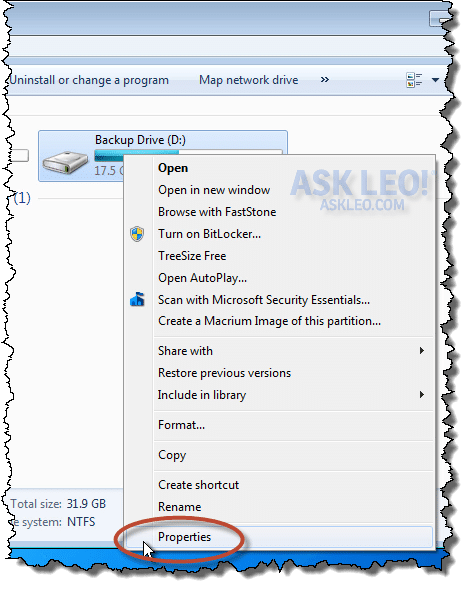
ClickBackdrop. In the resulting dialog box, click the Tools tab.

Click the Check at present… button.
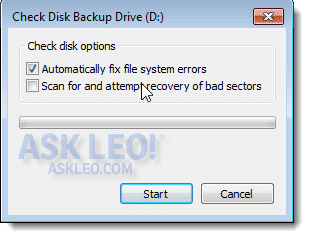
There are two options presented before CHKDSK begins its piece of work:
- Automatically prepare file system errors. If not checked, CHKDSK will simply report,but not fix, any issues that it finds.
- Browse for and attempt recovery of bad sectors. This is a more than time-consuming scan of the deejay that I'll hash out below.
In general, the default setting is fine when you doubtable at that place is a trouble that needs to be fixed.
Click Start, and you lot may become this message:
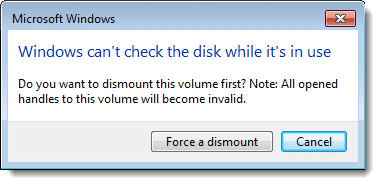
CHKDSK can only check or repair a deejay when information technology is the only program using that disk; even the rest of Windows cannot exist accessing the disk while CHKDSK does its job. Forcing a dismount makes that happen. If a program is really accessing the drive or files on the drive about to be dismounted, the old "results are unpredictable" phrase applies. Programs may merely observe and exercise the right thing; they may crash or something inbetween.
That's why the mutual advice is to close nearly programs when running CHKDSK, or at least make certain none can access the drive you're about to check.
Click Force a dismount and CHKDSK begins its work.
Eventually, this is the bulletin you hope to see:

"See details" displays a log of CHKDSK'southward activity. Any errors to be repaired would be listed here.
CHKDSK on a system drive
Recall how I said CHKDSK requires exclusive access to the drive in club to be able to repair it? And that even Windows tin't exist accessing the disk?
That presents a problem when you want to CHKDSK the arrangement drive – typically your C: bulldoze. If Windows is running, then by definition, it accesses the system bulldoze almost constantly.
The solution is to run CHKDSK before Windows runs.

If you attempt to CHKDSK your system drive, instead of getting the option to dismount it (not something that can be done while Windows is running), yous'll get a bulletin offering to run the CHKDSK before Windows is loaded the adjacent fourth dimension you reboot.
Click Schedule disk check. At present, reboot your motorcar. As the machine reboots, you'll see something like this before Windows loads:

Once completed, Windows volition load usually.
Getting the results of a scheduled CHKDSK
A very common question is where to get the results of a CHKDSK that ran before Windows started. There's no pause, and the data shown above disappears as presently as Windows starts to kicking.
Run the Event Viewer past clickingGet-go, and then Run, (or type Windows Central + R). Enter in eventvwr and click OK.

In Result Viewer, click the Application log under "Windows Logs". Look for the line detail that ends with Wininit (for Windows Initialization) and has "Checking file arrangement on C:" in the lower General tab.

To brand reading the results easier, just double-click on that Wininit line.
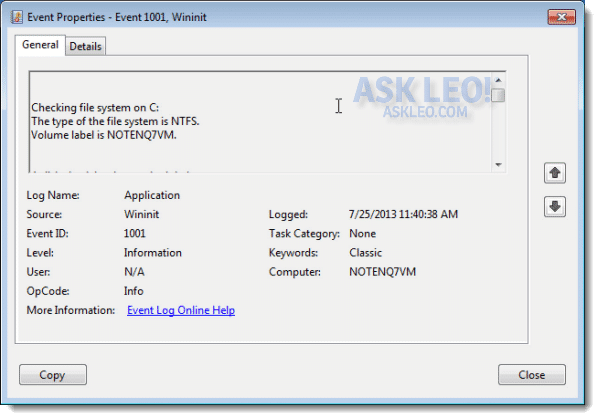
The scrolling box most the top contains the results of CHKDSK that scrolled by on the screen before Windows loaded.
CHKDSK via command line
CHKDSK is a command-line tool. All of the options above simply run that same tool in some fashion that captures its output.
You can do that direct yourself.
Click on Start, All Programs, Accessories, and then right-clickCommand Prompt.
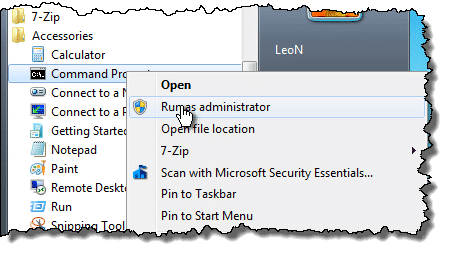
ClickRun as administrator,consideringCHKDSK does require administrative access to do its job.
In the Command Prompt, type:
CHKDSK /F
…to run CHKDSK with the "/F" or "fix" parameter. Without /F, CHKDSK will but report, but not repair, whatsoever errors.

Every bit you tin can see, the example to a higher place checks the D: drive, and just every bit in the windowed interface, CHKDSK must dismount the bulldoze before it can be checked.
If you lot run CHKDSK confronting the C: drive,

…information technology similarly requests that the CHKDSK be scheduled at the next reboot.
Scanning for bad sectors
Normally, CHKDSK simply checks that the information stored on the disk is correct. There'due south a fair amount of overhead information that tells Windows where files are located and how they're really stored and distributed around the disk media. CHKDSK uses its knowledge of what this data is supposed to look like to ensure it's correct and try to fix it when it's not.
Scanning for bad sectors is another thing entirely. When this pick is selected, CHKDSK actually reads the unabridged disk, not merely the overhead data. Equally a outcome, a bad sector scan takes significantly longer than a simple CHKDSK.
As CHKDSK reads, information technology notices if those reads actually succeed. When they practice not, it marks the area that failed as "bad" so that the system won't attempt to write more information into those areas with problems.
It's important to notation that this scan doesn't test whether the information found is good or valid – simply that it tin in fact be read.
As we saw before, scanning for errors is a simple checkbox when you run CHKDSK from Windows Explorer. For those that prefer the control line, it's the "/R" – repair – option.
When to CHKDSK
Ordinarily, CHKDSK just need be run when a problem is suspected.
In particular, a scan for bad sectors simply needs to exist done once you've actually encountered a bad sector – ordinarily in the form of a bad read, write, or explicit CRC mistake. CHKDSK will do what it can, but most chiefly, it will remove the bad expanse from use.
Running CHKDSK to simply check the validity of the file organisation is a quicker performance, and it's not unreasonable to run it every and then often, peculiarly if your automobile has been crashing. In nearly cases, Windows will actually force a CHKDSK after a system crash or improper shutdown. This is done non to fix the cause of the crash (although in some cases it could), simply rather to set any disk-related issues that may have resulted from the crash.
What CHKDSK won't do
While we talk about CHKDSK "repairing" a hard deejay, it is not a information recovery tool per se. Its chore is not to recover lost or damaged files, but to ensure that the information currently on the deejay is in a consistent and condom state.
When it comes time to search for files accidentally lost or deleted, then you need to use tools similar Recuva and similar.
If yous're trying to recover data from a hard drive that has a persistent media problem, or is so damaged that a CHKDSK scan for bad sectors can't assistance, then a tool similar SpinRite might be your only option.
Unless, of course, you have a fill-in and tin can simply supervene upon your failing difficult drive.
What Does Scanning And Repairing Drive D Mean,
Source: https://askleo.com/checking-and-repairing-a-disk-with-chkdsk/
Posted by: trevinopopop1971.blogspot.com


0 Response to "What Does Scanning And Repairing Drive D Mean"
Post a Comment